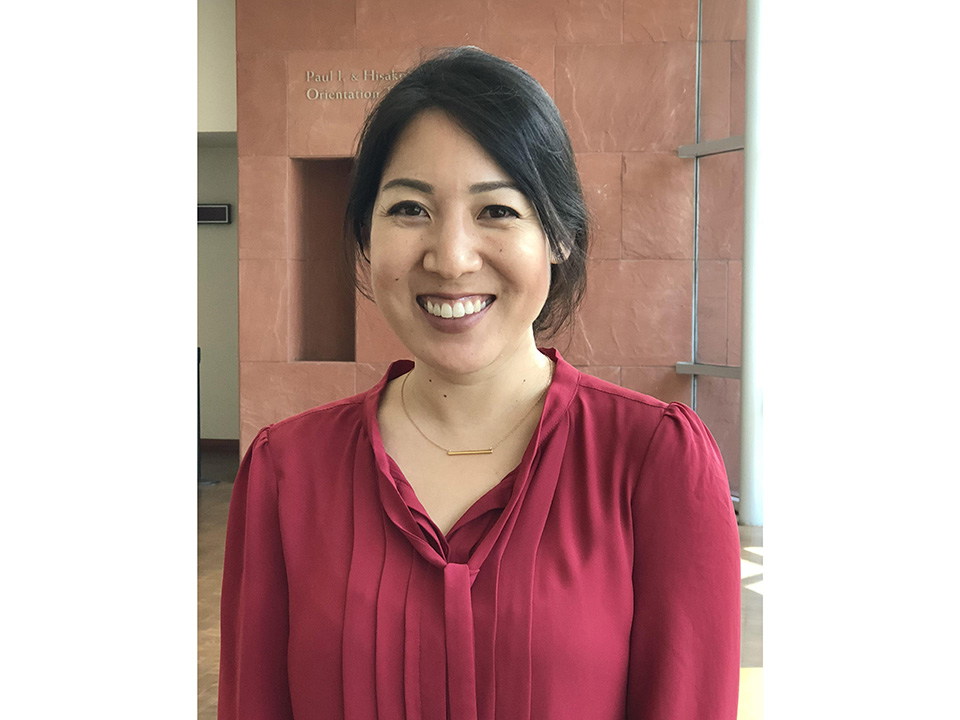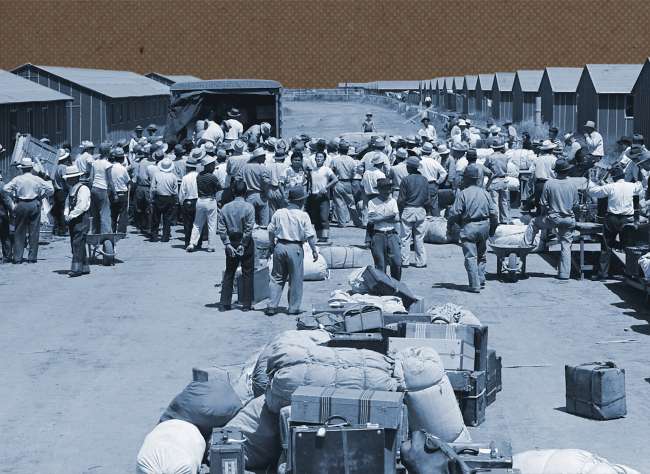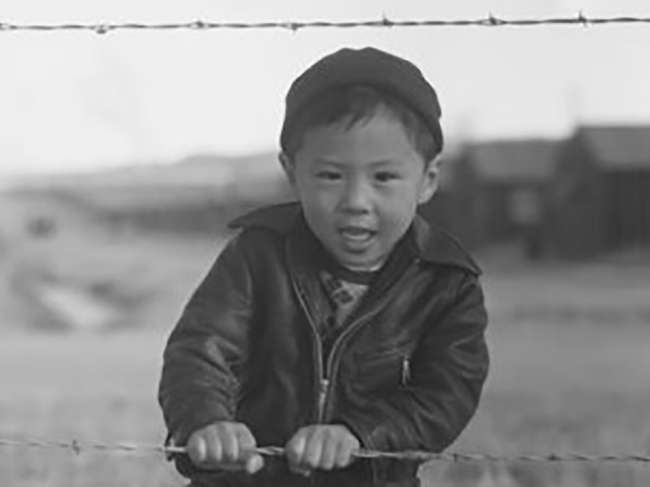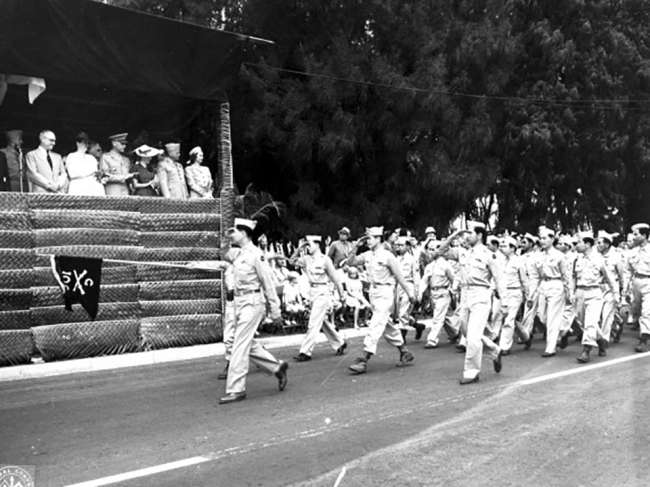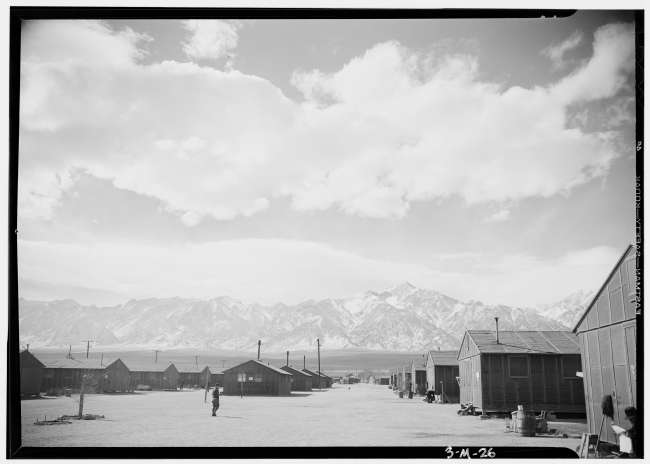Top Image: Children residing at a temporary trailer installation in Burbank, CA in 1946, following their return from America’s concentration camps. Japanese American National Museum (Gift of Ronnie Macias and Raey Hirata, 97.1.3a)
In late October 1945, Kimiko Keimi and her 13 year old son, Harold “Hal” Keimi, left Heart Mountain, Wyoming, one of America’s concentration camps, to return to Los Angeles. Although they were returning to their hometown, they were unable to reclaim their house, which was adjacent to the laundry that they previously operated in Hollywood. Instead, their final destination became a temporary trailer installation, which the federal government opened for Japanese Americans returning from America’s concentration camps. The trailer that the two shared felt like anything but home. The same could be said for the room that they later shared within a San Fernando Valley home, which Kimiko received as part of her compensation for domestic work. For the first time, the Keimi family was forced to split apart.
In August 1945, oldest son Albert left Heart Mountain ahead of the family to start his final year at Hollywood High School. He would work as a schoolboy, doing chores for a family in Hollywood, in exchange for room and board. A month prior, Thomas, Kimiko’s husband, departed for the Pacific Northwest to take up employment with the railroad. Once Hal recovered from the illness that kept him and his mother at Heart Mountain through the baseball World Series, which Hal listened to intently while he was in the camp infirmary, they qualified for indefinite leave. Kimiko likely hoped that the familiarity of their prewar home would make it easier to reestablish a semblance of a normal life again, as they awaited the day when they would be reunited with the rest of the family. Although Kimiko was distraught over her family’s plan to split up, she knew it was necessary if they were to reestablish the life they previously led before the war. Kimiko and Thomas intended to regain stability for their family, but it would take several years before the family would be reunited. For the Keimis, like so many other Japanese American families, the continuous upheaval that began with the forced removal from the West Coast in 1942, continued with incarceration in temporary detention centers, later in America’s concentration camps, and ultimately persisted into the postwar period.
On February 19, 1942, President Roosevelt issued Executive Order 9066, which established a military zone on the West Coast of the United States and determined that the military had the authority to exclude anyone it deemed necessary. There was no specific description of who might be included, but it ultimately laid the foundation for the forced removal and subsequent incarceration of over 125,000 individuals of Japanese ancestry, two thirds of who were American citizens. While the Japanese American population was relatively small in comparison to the demographic makeup of the United States, the concentration of the population was disproportionately on the West Coast—in California, Oregon, and Washington. While the executive order was issued shortly after Japan’s attack on Pearl Harbor, it was not solely in response to this one act. Instead, it was part of a continuum of a long history of prejudice and discrimination aimed at Japanese immigrants and their American-born children. Detention in America’s concentration camps was never intended to be indefinite.
The objective of the War Relocation Authority, the government agency established to oversee the camps, was to break up concentrations of the Japanese American population on the West Coast by dispersing it widely across the country. Very early on, if incarcerees could demonstrate their loyalty and prove acceptance to a university or offer of employment and housing, they were eligible for indefinite leave. Initially, they could not return to the exclusionary zone on the West Coast. Instead, the War Relocation Authority used promotional brochures and pamphlets, to entice incarcerees to resettle in cities such as Chicago, Cincinnati, Minneapolis, Detroit, and New York.
In December 1944, a test case known as Endo v. United States went before the US Supreme Court to challenge the ongoing mass detention of Japanese Americans, solely on the basis of race. Mitsuye Endo, who was a California state employee prior to World War II, claimed that exclusion from the West Coast prevented her from continuing with her employment. The US Supreme Court ruled in favor of Endo, but was quite careful not to address the topic of constitutional rights. The Supreme Court ruling resulted in the War Department issuing a statement saying that persons of Japanese ancestry…”would be permitted the same freedom of movement throughout the United States as other loyal citizens and law-abiding aliens,” effective January 2, 1945.
Although former incarcerees were allowed to return to the West Coast, the arrival of returnees was slow at first. Prior to the war, approximately 36,000 Japanese Americans resided in Los Angeles County. Yet, fewer than 300 had returned to the formerly restricted territory a month after it had reopened. By August, the number was up to approximately 2,000 and was projected to increase to 3,000 by the end of the year.
A young child sits among personal belongings as she awaits departure from Heart Mountain concentration camp in Wyoming, 1945. Japanese American National Museum (Gift of:June Utako Morioka, 92.86.13)
Fears of impending violence and discrimination towards Japanese Americans on the West Coast spread amongst incarcerees, causing many to feel apprehensive about reintegrating into mainstream society and returning to the West Coast. Prejudice became exacerbated on the West Coast during the war, even though people of Japanese ancestry had summarily been removed. It continued to grow, despite the Allied Forces’ success in the Pacific and European theaters and the contributions of the 442nd Regimental Combat Team, an all Japanese American segregated military unit, on the front lines.
Others, who were forced to liquidate their businesses, give up their homes, and sell their material possessions prior to the forced removal, felt they had nothing to return to on the West Coast. With little choice, they decided to make home again elsewhere.
Nine months after the exclusionary ban was lifted on the West Coast, the War Relocation Authority set deadlines at the end of the year to close the camps, with the exception of Tule Lake concentration camp in California. Yet, with some 55,000 Japanese Americans remaining in America’s concentration camps as of April 1945, the WRA staff decided to go against its overarching objective, by returning remaining incarcerees to their point of origin. By October, government officials projected that 12,000 to 15,000 individuals would return to Los Angeles County by the end of the year. The majority of those who returned to the West Coast towards the end of 1945—mostly older adults, families with young children, and individuals without families, were prompted by the WRA’s directive.
Returnees arrived to find that the prejudice they encountered before the war did not vanish simply because the United States was no longer at war with Japan. Yet, while returning to a hostile social climate proved difficult, the most pressing challenges centered on securing housing and employment. The housing shortage, which was a challenge prior to the war, became the most acute issue in California. The combination of migrants who arrived during the war, GIs making their way home from overseas, and returning Japanese Americans who had been forcibly removed during the war added further strain to the housing situation. Hostels, hotels, and trailer installations provided temporary shelter for returning Japanese Americans who had no other options. Racial housing covenants continued to put restrictions on where Japanese and other people of color could purchase homes. Similarly, prejudice limited the job opportunities for returning Japanese Americans, relegating them mostly to work in domestic service, gardening, and the garment industry.
And yet, despite the arduous challenge that Japanese Americans faced upon returning to the West Coast, they persisted. Even though the federal government intended to break up concentrations of the Japanese American population on the West Coast, the population nearly returned to its prewar numbers. Churches and temples, community centers, cultural institutions, businesses, and Japanese language schools helped to anchor the Japanese American community once again. Former incarcerees deliberately decided not to dwell on the past and chose to look forward, instead.
While this mentality may have helped the community to rebuild, it had its consequences. The pain and trauma that Japanese Americans experienced during World War II has continued to affect subsequent generations. The healing process continues today, long past the formal apology and reparations that came with redress. It remains important to focus on this aspect of US history—not just to remember, but also to ensure that this never happens again. This episode in history is a reminder of the fragility of our Constitution and the need to safeguard civil liberties for all.
Meet the Author
Kristen Hayashi, PhD is a public historian as well as director of collections management and access and a curator at the Japanese American National Museum. Her area of research examines the resettlement of Japanese Americans in post-WWII Los Angeles, following their return from America’s concentration camps.
Note on Terminology:
The Japanese American National Museum as well as scholars of the WWII incarceration of Japanese and Japanese Americans in the United States refer to the 10 camps where civilians were incarcerated as America’s concentration camps, rather than internment camps. Government officials all the way up to President Franklin D. Roosevelt initially referred to them as “concentration camps.” The federal government soon began to refer to them euphemistically as “internment camps.” Internment, however, refers to the detention of “civilian enemy nationals.” The majority of Japanese and Japanese American incarcerees who were detained amongst the ten “War Relocation Centers,” which the War Relocation Authority administered, were US citizens by birth. Using the term “internment camp” for the 10 War Relocation Centers, which infers the detention of enemy aliens, is misleading. Additionally, the Department of Justice operated camps detained “enemy aliens,” mostly Japanese immigrants, but also Italians and Germans, as well. Japanese immigrants were considered “aliens ineligible for citizenship” because of discriminatory legislation that excluded non-whites from naturalization. “America’s concentration camps” is a nuanced term to describe the camps here in the United States and distinguish them from the concentration or death camps in Europe. For more on terminology, visit Power of Words.
Foot Notes and Further Reading
Harold Keimi, interview by Kristen Hayashi and Steve Nagano, 29 Aug 2017. Details regarding the Keimi family’s indefinite leave were gleaned from the War Relocation Authority’s “Final Accountability Roster” for Heart Mountain, Wyoming.
Recent scholarship is estimating the number of incarcerees detained in both the War Relocation Authority-administered camps and Department of Justice camps to be closer to 125,000.
Brian Niiya, ed. “Endo, Ex Parte,” Encyclopedia of Japanese American History: An A-to-Z Reference from 1868 to the Present, Japanese American National Museum, 2001: 159-60.
Robert Sullivan, “Japanese-Americans Trickling: Evacuees Slow to Stick Necks Out as Ban on West Coast is Lifted,” (publication unknown) 4 Feb 1945. UCLA Special Collections, Melvin P. McGovern Papers, Collection 2010, Box 120, Folder 10.
Letter from Earl L. Kelley, District Relocation Officer to Hon. Helen Douglas, Congresswoman, 3 Aug 1945. National Archives, PI-77 47, Box 75, Folder 301.3.
“1,438 Evacuees Back on Coast, Myer Reports,” Pacific Citizen,Vol. 20, No. 15, 14 April 1945. Speech by Paul Robertson, WRA (Southern California) Area Supervisor, 18 Sept 1945. National Archives, PI-77, Box 76, Folder 315.
Cite this article:
MLA Citation:
APA Citation:
Chicago Style Citation:

